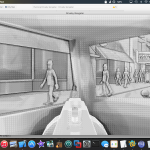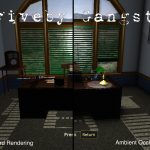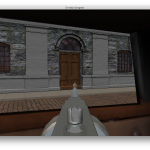So I got the ambient occlusion effect implemented in the actual game shader code. I followed the technique outlined in this article. I must say, it’s very subtle, but it looks nice. The real benefit here is that when I turn off the “check depth range” mechanism, I get a very awesome surreal dark outline around all of the models in the scene. This will be an excellent effect to use when I work on the second half of the game (which will use an artistic black and white noire post processing style signifying the protagonists slowly weakening grip on reality).
I didn’t understand how ambient occlusion worked at all before implementing the effect, but now I must say, I have a pretty reasonable grasp on it. Basically in one brief description, it takes random samples at every point on the surface to determine how much ambient light from the rest of the scene can reach that point. In other words, how much of the ambient light is occluded by other nearby surfaces. This is done by randomly sampling points within a small hemisphere emanating from the surface. What makes SSAO so nice, is that this technique is approximated entirely in screen space, making it reasonable for real-time rendering in a game. The downside is it seems to be a little noisy and I see artifacts from time to time on the screen, but hopefully I’ll be able to clean some of that up in time.
Below are some more progress shots showing the kinds of subtle shadowing I can achieve using SSAO in the VGLPP/DrivebyGangster engine.


